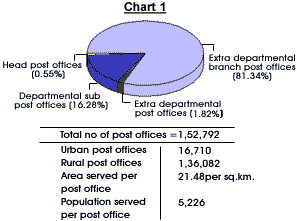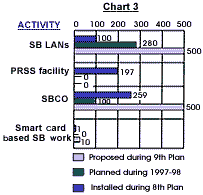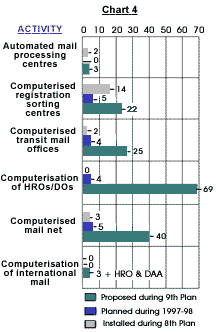|
October 6, 1997
HEADLINES
JOBS
COM:PORT
POLICY POLICE
ARCHIVES
|
N Vittal
Post-mortem
Is there life after death? Yes. The postal department
can be resurrected
if infotech plays Jesus Christ.
The Indian postal department is perhaps the largest in the world.
It employs 600,000 people and offers unique services like 'money
orders', a system to deliver cash at the payee's address.
Yet, the postal department is essentially a loss-making service.
It is the government's Cinderella department and gets much less
resources than it deserves. The perception that the department
can't be expected to generate revenue has now led to a situation
where 85 per cent of the budget is spent on salaries.
In fact, the department has become a metaphor of do-good socialism.
Decades ago, John Kenneth Galbraith described India's socialism
as 'post-office socialism'.
But all's not that bleak for India's postal services. For one,
it enjoys a better public image than, say, the rich cousin, the
Department of Telecommunications, of which it was a part till
1985.
 As it approaches the turn of the century, the postal department
is making valiant efforts to improve services and business. But
most of these endeavours are dwarfed by the sheer size of the
problem: There are 150,000 post offices in the country. About
25,000 are departmental sub-post offices. (See Chart 1).
As it approaches the turn of the century, the postal department
is making valiant efforts to improve services and business. But
most of these endeavours are dwarfed by the sheer size of the
problem: There are 150,000 post offices in the country. About
25,000 are departmental sub-post offices. (See Chart 1).
Can information technology save the day?
 During the government's Eighth Five-Year Plan period, 2,625 multipurpose
counter machines were installed in about 800 post offices. In
the Ninth Plan period another 4,900 may be installed. This should
cover about 1,000-1,500 post offices. At this rate it may take
two or three centuries before the present 150,000 post offices
are covered! (See Chart 2).
During the government's Eighth Five-Year Plan period, 2,625 multipurpose
counter machines were installed in about 800 post offices. In
the Ninth Plan period another 4,900 may be installed. This should
cover about 1,000-1,500 post offices. At this rate it may take
two or three centuries before the present 150,000 post offices
are covered! (See Chart 2).
The same is true of other aspects of postal administration. (See
Charts 3 to 8)
This slow pace in adopting information technology could be blamed
on the lack of a core team of technical experts within the postal
department. The department has to depend on other departments
or external assistance for implementing IT projects. This must
change.

In this article I propose a bold new vision - the 'Indian Post
Vision 2000'. The objective is to ensure that information technology
is used in the operation of the Indian post throughout the length
and breadth of the country so as to improve services.
IT will ensure that employee productivity of the postal department
goes up. The railways have shown that computerisation of the passenger
reservation system led to the same staff handling 40 to 50 per
cent additional work. A small experiment in the New Delhi Parliament
Street Post Office illustrates how by using multipurpose counter
machines, the number of counters has fallen from 352 to 273. A
saving of 79 counters. In other words, an additional workload
of 23 per cent can now be handled by the same staff.
 This is just the beginning. The savings will grow exponentially
in time. It is in the national interest and in the interest of
the economy that the entire postal system rest on information
technology.
This is just the beginning. The savings will grow exponentially
in time. It is in the national interest and in the interest of
the economy that the entire postal system rest on information
technology.
There is, however, the problem of resources. The postal department
is not a corporation and, therefore, will have to depend on budgetary
support from the government for any kind of expansion activity.
The government's resources are not much and this means that the
dream of having a completely computerised postal system will not
be realised. I have a 10-point strategy to make the impossible
happen:
- A deadline is needed. The postal department moves slowly.
It needs to be flipped into the fast-forward mode. As part of
its initiative to
|
Chart 5
|
|
Activity
|
Installed during 8th Plan
|
Planned during 1997-98
|
Proposed during 9th Plan
|
|
Computerised custom care
|
7
|
29
|
500
(approx)
|
|
Facilitation counters
|
-
|
423
|
4,000
|
|
Track and trace facility
|
8
|
-
|
50
|
|
Booking and delivery
|
60
|
-
|
-
|
|
Business offices
|
-
|
-
|
5
|
|
Premium product cells
|
-
|
8
|
40
|
|
Customer care centres
|
-
|
1
|
5
|
|
Networking circles with HQs
|
-
|
All
|
-
|
become more responsive to the people, the government
could declare that the entire postal department has to be computerised
by December 31, 2000. That gives us three years.
- The government must also declare postal services are infrastructure
like power, ports, roads and telecommunications. This will ensure
availability of funds at attractive rates from institutions like
the Infrastructure Leasing And Financial Services or the Infrastructure
Development Finance Corporation. Once funds have been mobilised
the government will need to (a) persuade a sea of officers and
employees in the department that their jobs are not on the line
and shunning tehcnophobia will benefit them beyond their imagination.
(b) The technical design of the system
|
Chart 6
|
|
Activity
|
Installed during 8th Plan
|
Planned during 1997-98
|
Proposed during 9th Plan
|
|
VSATs
|
74
|
-
|
200
|
|
ESMOs
|
265
|
-
|
2,000
|
|
HUB
|
-
|
-
|
1
|
from the software and hardware
points of view will have to be worked out. A strategic decision
must, therefore, be taken to contract out installation and maintenance
of the systems. The work could be awarded to private or public
sector companies.
- The basic idea is that the IT infrastructure for the postal
department will be funded and operated essentially by external
agencies and not the employees of the postal department. The postal
services, of course, will be
|
Chart 7
|
|
Activity
|
Installed during 8th Plan
|
Planned during 1997-98
|
Proposed during 9th Plan
|
|
Rural PLI work
|
-
|
6 regions
|
Balance 39 regions
|
|
PLI network
|
All circles except J&K and O/o director PLI Calcutta
|
J&K circles and O/o director PLI Calcutta
|
Upgradation of existing system where required
|
operated by the employees of the
postal department who will use the IT infrastructure which will
be kept ready for their use.
- Standard hardware and software may be prescribed. As the postal
department does not have the required technical manpower, the
Department of Electronics can form a separate division to help
it. The division could physically place its officers in the postal
department. The services of the National Informatics Centre, the
Indian Institute of Technology and technical experts from elsewhere,
even from the private sector, could be availed of. In the postal
department itself, it will be necessary to create an IT brains
trust. This can be headed by a member of the board or even the
chairman himself. Enthusiastic and committed officers of the department,
irrespective of seniority, may be brought into the brains trust.
In addition, knowledgeable people from other departments and organisations,
who can make their technical expertise available to the postal
department must be included. When I was secretary, DoE, in the
effort to introduce a money order transmission via VSAT, officers
of the DoE were physically placed in the postal department to
work in collaboration with the officers there to evolve the system
successfully.
- The various services of the postal department, for which computers,
hardware and software are needed can be contracted out to various
companies on standard terms. These terms should include not only
provision but also factors like uptime and service quality. In
the case of Navodaya Vidyalayas, for instance, a contract was
given to a private company to provide not only the teacher but
also the hardware to ensure that the teaching of the computers
in the CLASS programme (computer literacy in schools) was successful.
Similarly, the hardware and software, as well as the servicing
of the various systems should be contracted out, nation-wide,
to the various computer companies. We can begin with the 25,000
departmental head and sub-post offices. In fact, with 150,000
post offices in the country, there is a tremendous market opportunity
and the Indian computer industry should seize it. The government
will be able to get the best of terms in this deal. Business,
after all is a win-win exercise.
-
|
Chart 8
|
|
Activity
|
Installed during 8th Plan
|
Planned during 1997-98
|
Proposed during 9th Plan
|
|
Administrative offices
|
-
|
Four in directorate
|
Rest of the directorate branches
|
|
Linking circles / Regions with directorate
|
-
|
-
|
All
|
|
Phiately bureaux
|
-
|
15
|
252
|
|
DAP offices
|
-
|
8
|
All the rest
|
|
Postal stock depots
|
15
|
Rest of the PSDs
|
N.A.
|
The postal department should acquire these systems on lease
from the private parties. Of course, they will be used by the
postal staff for operating the services. The lease charges can
be substantially brought down if the finance ministry extends
concessions under the Income Tax Act such that any investment
made in IT systems would be eligible for 100 per cent depreciation
in the first year itself. As has happened in the case of wind
farms, the leasing companies must be able to provide systems at
an interest rate of 12 per cent which will be an attractive rate
for the postal department. Incidentally, the leasing system will
also avoid the difficulty arising out of the lack of technical
manpower in the postal department. It will ensure that the IT
systems of the posts never become obsolete because as the technology
changes, it should be possible to continually update the hardware
and software used in the postal system. After all, it is the private
companies who have to provide the systems as specified by the
postal department.
- The Infrastructure Leasing and Financial Services and the
Infrastructure Development Finance Corporation as well as other
financing agencies must be able to fund these massive operations.
- With the introduction of IT in the postal department, the
business opportunities arising in the private sector need not
be restricted to the big players though they may dominate in the
larger urban areas. When IT comes to smaller areas and villages,
perhaps self-employment schemes like the Jawahar Rozgar Yojana
and the Prime Minister Rozgar Yojana can be modified to cover
educated, computer literate, young technicians and technocrats
who can take on contract work. In this way, the effort of applying
IT in the postal department will generate additional employment
opportunities without draining the government's budget.
- We had mentioned earlier that one of the objectives of computerisation
is to see that the manpower requirements of the postal department
do not go up and additional workload is handed by the same staff.
There could be resistance from the unions. Now, this can be overcome
by offering the employees of the postal department the option
of taking voluntary retirement or even becoming a contractor for
the department while retaining their lien in the department for
a period of, say, five years. So, as contractors, postal employees
can provide the same services which were visualised for the individual
technicians under the Jawahar Rozgar Yogjana or the Prime Minister
Rozgar Yojana.
- Another important technical requirement for the entire postal
service is the need for a countrywide reach. The postal department's
experience in the VAST money order system shows that they could
put up only 74 VSATs and cover a very small percentage of the
country. In order to provide nation-wide connectivity, all the
private companies as well as government departments which have
a telecom infrastructure should be permitted to make their facilities
available to the postal department on reasonable terms. In other
words, the terms should cover the operating cost for the departments/organisations
concerned with a marginal element of profit. Postal service is
generally a public service and it can not be a high profit-making
service. In this way, for instance the railways can make their
communication network available to the postal department. Organisations
like NICNET and ERNET of the DoE could also make available their
systems so the department. PSEs like ONGC, BHEL and SAIL who have
got microwave and other telecom facilities can also make their
surplus capacity available. With these network facilities being
available to the postal department, it can substantially enhance
its reach and cover the whole country very effectively.
A strategy on the above lines will make it possible for India
to substantially modernise its postal system and significantly
improve its service to the public.
Previous columns: Critical mass | T.R.a.I | Santa Clause 11(2) | The Broadcasting Bill | The death of distance | S.O.S, getting the message out of the bottle | Force 7 from FICCI | Of railroads and info highways | Techno Politics | Cheating death: Ways to resurrect ITI | The HAM-handed miracle | Electronic governance | Which came first? | The four-engine design | Learning to learn | Heads 'n hands
Tell us what you think of this column
|


 As it approaches the turn of the century, the postal department
is making valiant efforts to improve services and business. But
most of these endeavours are dwarfed by the sheer size of the
problem: There are 150,000 post offices in the country. About
25,000 are departmental sub-post offices. (See Chart 1).
As it approaches the turn of the century, the postal department
is making valiant efforts to improve services and business. But
most of these endeavours are dwarfed by the sheer size of the
problem: There are 150,000 post offices in the country. About
25,000 are departmental sub-post offices. (See Chart 1).
 During the government's Eighth Five-Year Plan period, 2,625 multipurpose
counter machines were installed in about 800 post offices. In
the Ninth Plan period another 4,900 may be installed. This should
cover about 1,000-1,500 post offices. At this rate it may take
two or three centuries before the present 150,000 post offices
are covered! (See Chart 2).
During the government's Eighth Five-Year Plan period, 2,625 multipurpose
counter machines were installed in about 800 post offices. In
the Ninth Plan period another 4,900 may be installed. This should
cover about 1,000-1,500 post offices. At this rate it may take
two or three centuries before the present 150,000 post offices
are covered! (See Chart 2).
 This is just the beginning. The savings will grow exponentially
in time. It is in the national interest and in the interest of
the economy that the entire postal system rest on information
technology.
This is just the beginning. The savings will grow exponentially
in time. It is in the national interest and in the interest of
the economy that the entire postal system rest on information
technology.